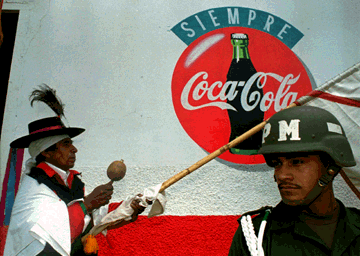Mar
16
Futebol and Telenovas
Posted by: Brian | March 16, 2009 | Comments Off on Futebol and Telenovas
I quite enjoyed the 4 articles by Alex Bellos that were extracted from “Futebol: The Brazilian way of life. The first chapter was written very passionately with excerpts from other authors that add to the strength of the emotional connection that Brazil has to this sport. Here, Bello’s talks about ‘The Fateful Final,’ Brazil’s devastating loss to Uruguay in the 1950 World cup. Bellos goes on to carefully describe the final moments, the rare silence of the stadium, the individual reactions and the outcome of the player’s lives. The game seemed to change some aspect of each individuals life that witnessed or even heard about the event. This was not just because a ‘game’ was lost, it was because ‘hope’ was lost.
The Brazilian team had been immensely successful up until the end, and this success had broken boundaries between this diverse country and united everyone together in hope and equality. On Page 54, Bello’s says that “Second place in a World Cup was Brazil’s best ever result yet it felt like a failure.” On page 55 he follows up to this by quoting writer Jose Lins do Rego who stated “I saw a nation defeated—more than that—on without hope.”
The second chapter was more of a historical tale of the history and formation of the sport. The third chapter told the story of ‘The Angel with Bent Legs,’ the story of a wildy successful football player, with below average intelligence and malformed legs that was a sports icon. Bello’s contrasts him to another famous footballer, Pele, who was the super-athlete, highly successful, good body, and highly organized. Pele assisted in the wins of 3 world cups, which is more than anyone else as a player.. but never really stood out like Garrincha in the publics eyes.
Garrincha’s story was controversial; he was born with a natural ability, and lived a life of vices and foolishness. However, the public simply adored him. Partially due to a general obsession with a life gone sideways, but also possibly due to his humble background, his overcoming of the odds, and never living like a wealthy man making it so that is some roundabout way, he was ‘ordinary.’
The last chapter, carnival with a twist, displayed more of Bello’s passionate prose once again as he talks about particular eccentric futebol fans in addition to Brazilian futebol fans altogether. A particularly meaningful line in this chapter is on Page 127 when he says “The Brazilian urge to dress up—which turns football in to carnivalesque blocks of color—seems to be particularly powerful because beneath the clothes there are few countries as racially diverse or socially unequal.” By uniting together for their team, they can, if only for that game, ‘forget their violent differences that mark day-to-day life” (127). This drives home the point from the first chapter of the utter despair felt when it was all over for them, when they lost the game, their moments of unity had ended.
The second reading on Venezuelan Telenovas was quite interesting. Although they are similar to typical American ‘soap operas,’ they have much more cultural significance in Latin America then they would to the average American. By intending to represent everyday life in Latin America, they attempt to emphasize the importance of the ordinary and bridge the contemporary worlds of the rich and the poor.
Telenovas have branched off in to different types, including historical and political ones that focus on economic and political situations in the country that instigated public interest and debate. The author focuses particularly on one Venezuelan telenova, Por Estas Calles, that went so far as to ‘threaten the political life’ of the country by bringing up controversial issues that got the public talking.
